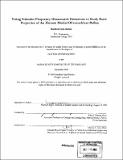Using stimulus frequency otoacoustic emissions to study basic properties of the human medial olivocochlear reflex
Author(s)
Backus, Bradford Clark
DownloadFull printable version (13.43Mb)
Alternative title
Using SFOAEs to study basic properties of the human MOCR
Other Contributors
Harvard University--MIT Division of Health Sciences and Technology.
Advisor
John J. Guinan.
Terms of use
Metadata
Show full item recordAbstract
The medial olivocochlear reflex (MOCR) is a brainstem-based neural feedback circuit by which mammals adaptively adjust the gain of their ears in response to changing environmental conditions. Activating the reflex with sound reduces cochlear gain, but the mechanisms by which the reflex produces its cochlear effects, the role(s) the reflex plays in hearing and many basic reflex properties are not well-understood. This thesis quantifies four basic properties of the reflex in humans using stimulus-frequency-otoacoustic-emissions (SFOAEs) that address the following issues: (1) The relative strengths of ipsilateral and contralateral reflex pathways (2) The reflex time-course (3) The response of the reflex to amplitude modulated (AM) noise (4;) The distribution of reflex strengths across a normal-hearing population Activating the reflex with ipsilateral or contralateral noise produced, on average, the same effect in cochlea at the 1 kHz place, contrary to expectations based upon animal studies. Simultaneous bilateral activation produced an effect that was equivalent to the sum of ipsilateral and contralateral activations, on average. Thus, no prevailing binaural interaction took place for our stimulus. Activating the reflex caused detectable changes in the cochlea within 25 ms; the changes continued to develop for 100's of milliseconds. (cont.) The decay rate upon reflex deactivation was generally faster than the onset rate ([tau]decay= 159 ± 54 ms, [tau]onset =277 ± 62 ms). In addition, our characterization of onset and decay time-courses suggested that a single second order cellular process (probably in outer hair cells) may govern the bulk of both time-courses. The reflex is not fast enough to protect the ear against loud impulse sounds such as gunshots. Amplitude modulating a wideband noise used to activate the reflex did not, in general, produce larger effects as had been previously reported. The question of whether AM can enhance MOCR responses under some circumstances for some subjects remains unanswered. AM rates important for information in speech (2 - 11 Hz) produced a DC MOCR response. It is possible that conversational speech primes the MOCR to a level conducive to detecting speech in noise. Inter-subject differences were found in the cochlear effects at the 1 kHz place when the MOCR was activated. One difference was a subject-specific rapid frequency variation. This finding called into question basic assumptions of how MOCR activation changes SFOAEs. Averaging across frequencies revealed a second subject-specific difference that was attributed to differences in the regional strength of the reflex (near 1 kHz) between subjects. (cont.) Regional strength varied by a factor of 7 across 24 subjects. Since a strong MOCR has been shown to protect the ear against acoustic trauma in animals, otoacoustic emission-based tests of reflex strength may help predict susceptibility to acoustic trauma in humans; this study demonstrates that such tests are feasible. The basic properties of the MOCR quantified by this thesis contribute to our understanding of the cellular mechanism that generate the reflex's effects, provides insight into the role(s) the reflex plays in hearing, and may eventually lead to clinically useful tests.
Description
Thesis (Ph. D.)--Harvard-MIT Division of Health Sciences and Technology, 2005. Vita. Includes bibliographical references.
Date issued
2005Department
Harvard University--MIT Division of Health Sciences and TechnologyPublisher
Massachusetts Institute of Technology
Keywords
Harvard University--MIT Division of Health Sciences and Technology.